You may find it a bit confusing at first to understand how rotations work when you are fairly new to volleyball…
It’s a bit more complicated than just “everyone moves one position” every time.
Don’t worry, I’ve got you covered…
With the help of diagrams and animations, I’ve created a straightforward guide that explains volleyball rotations in detail.
I promise to answer all your questions and you’ll be able to handle this stuff in no time!
Let’s get started!
How Do Volleyball Rotations Work?
During rotations, you must understand how to move physically around the volleyball court.
In every sideout, players rotate clockwise
When your team wins a point, every player on your team will rotate one position clockwise whenever the other team is serving.
Each of these ‘positions’ is referred to as a ‘zone on court’, with 1-6 being the numbers.
- Position 6: Middle Back
- Position 5: Left Back
- Position 4: Left Front
- Position 3: Middle Front
- Position 2: Right Front
- Position 1: Right Back
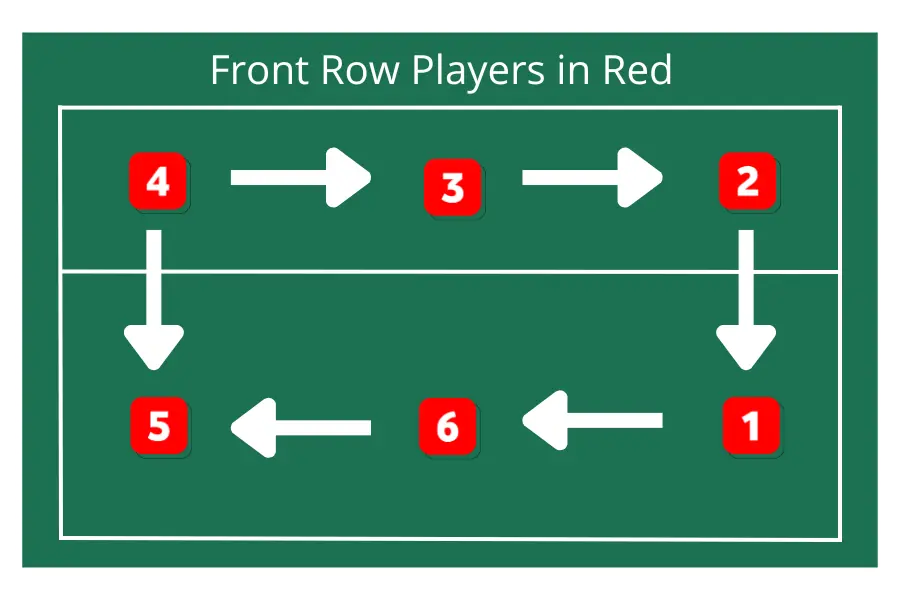
Here, I am not referring to player positions such as outside hitter, libero, setter, etc., but to these areas on the court or their numbers.
Later, we’ll talk about that.
The volleyball rotation rules
To avoid rotational violations, you need to know a few different rules.
Volleyball Overlap Rule
You should be aware of the ‘overlap rule’.
When the ball is served, you will be close to other players.
Before the serve, the overlap rule must be followed before you move anywhere on the court.
According to the rule, you cannot overlap with the person directly in front of you, behind you, or to the left or right of you.

In order to be clear,
- In position 4, the player must stay in front of the player in position 5, as well as to the left of the player in position 3.
- In position 5 it is imperative that the player stays behind the player in position 4, as well as to the left of the player in position 6.
- In position 6, a player must stay to the right of five and to the left of one, but must also remain behind three…
- Position 1 must remain behind 2 and to the left of 6.
- Position 2 must remain in front of position 1 and to the right of position 3.
- Position 3 must remain on the right side of 4 and the left side of 2, but they must also remain in front of 6.
Okay, that seems pretty straightforward, right? What is the tricky part?
Serve reception.
In order to pass effectively, you’ll want to move your players around the court so that your best passers are in the right position to pass, and your setters are close to the net in order to set.
There is actually plenty of room for players to move around the court without violating the overlap rule…
Your team may use the serve receive formation below.
Observe that neither of the players is violating the overlap rule, as indicated by the green animation.
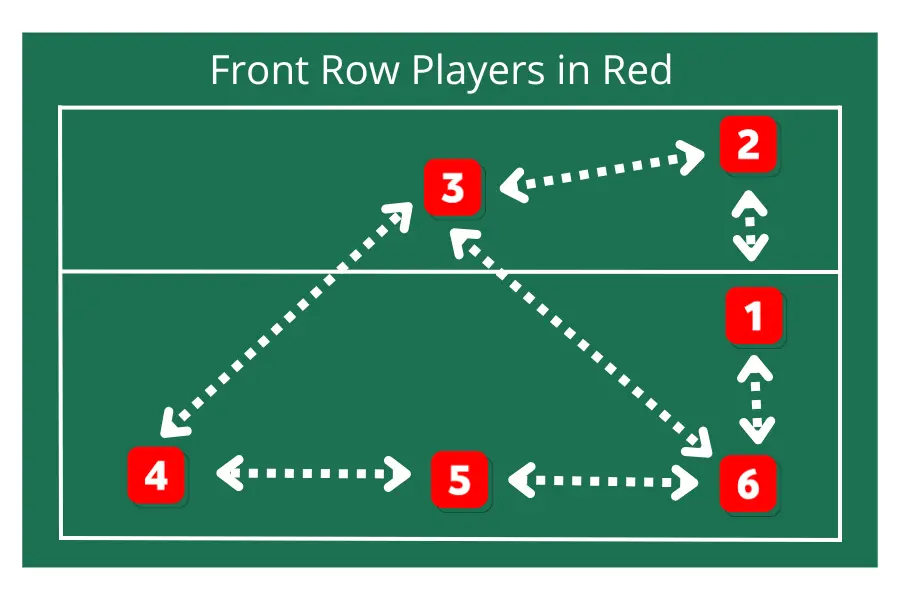
What’s going on here?
Now that position 5 has fallen off the net, position 4 is standing there.
For 4 to pass, five and six players moved over to the right.
It’s the setter (the player who started in 1) who’s pushing up onto the net and standing directly behind the player in 2.
There hasn’t been much movement for the player in 3.
In our team, we have three strong passers in the back row, and our setter is located directly at the net, right where they want to serve.
Overlap Rules Apply To Serving Teams As Well
The overlap rule still applies even when your team is serving.
Serving team members will run to their base positions as soon as the ball is contacted during serve.
The defending team’s players move to their bases after serving
A player’s base position on the court indicates where he or she will look to defend against an attack (setter, outside, middle, libero, opposite).
Players on the serving team initially respect the overlap rule, but when the ball is served, they overlap with one another and move into their bases.
The starting positions are shown below.
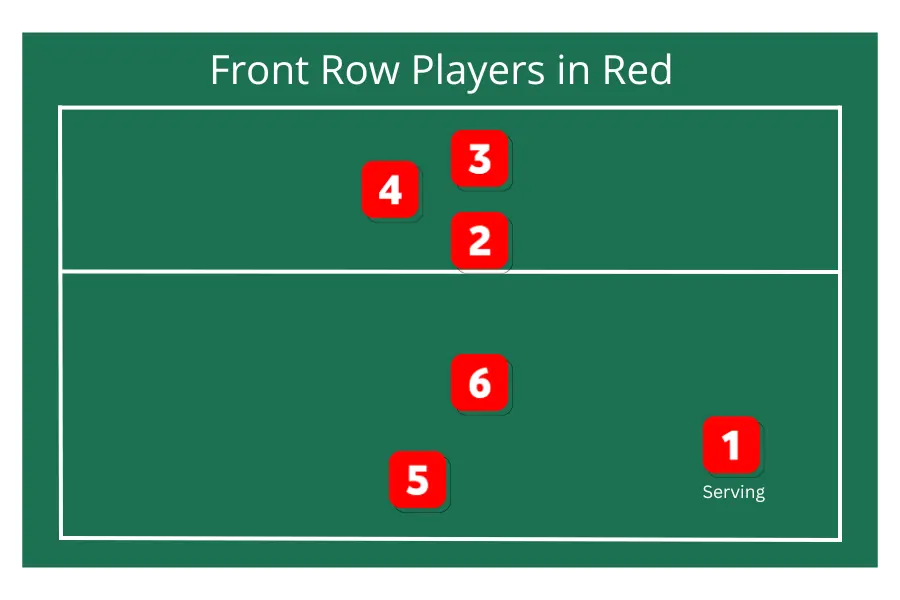
Upon serving the ball,
- In position 6, the libero moved to his base position (left back).
- In position 4, the opposite hitter moved to his base position (right in front).
- In position 2, the outside hitter moved to the base position (front left).
- Position 3’s middle blocker was already in his base position (front middle) as was position 5’s outside hitter (middle back).
Now that all players are in their base positions, they are ready to defend.
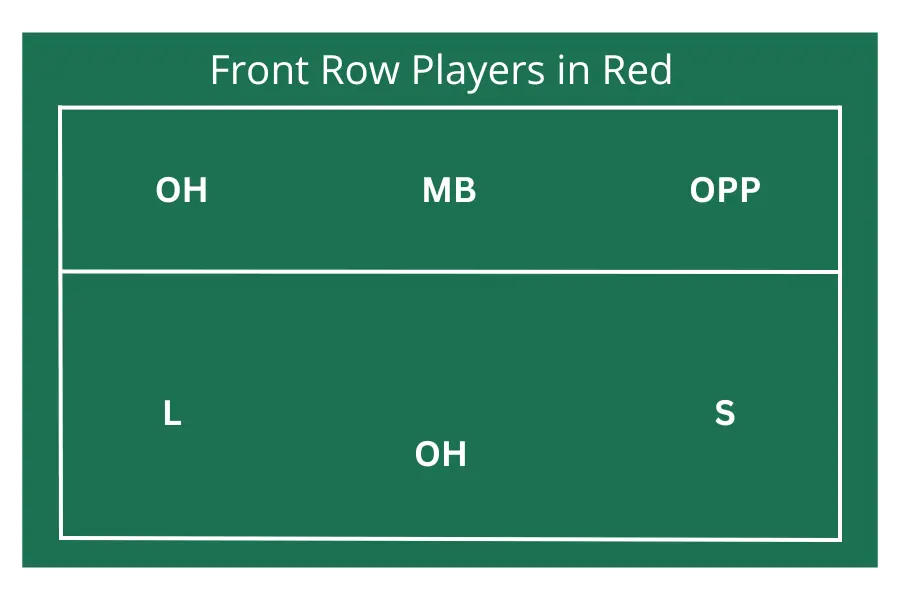
Positions of Players Must Mirror Each Other
Two outside hitters, two middle blockers, a setter, and an opposite hitter are usually on the volleyball court.
Every middle blocker and outside hitter must always be directly opposite one another.
There must also be an opposite setter and opposite hitter.
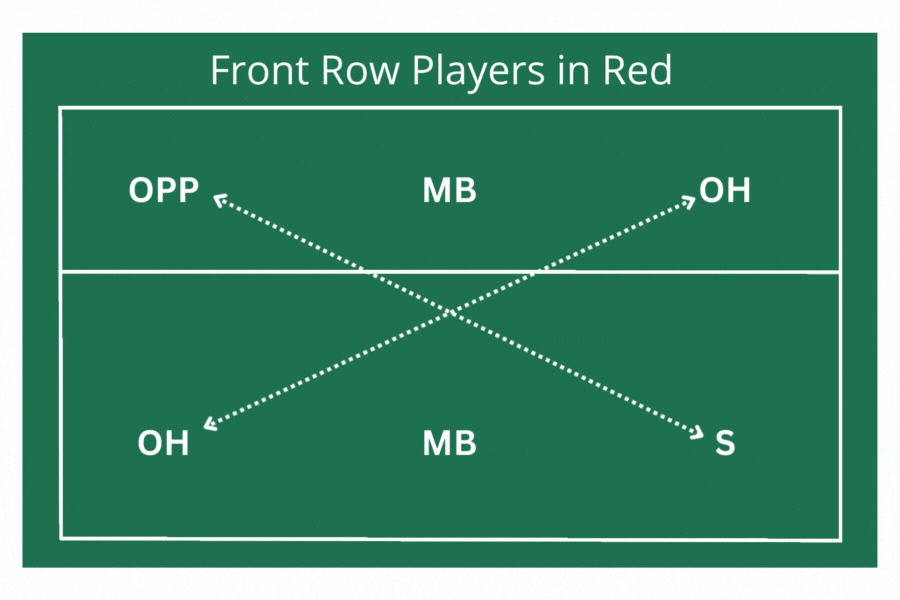
You should mirror the position of your fellow outside hitters on the court if you get confused about where you should be.
As long as your coach mirrors the relative positions of the players, he can begin a set with players at any position on the court (1-6).
If the setter was to begin in 1, the opposite would be in 4. The opposite would occur if the setter was started in 2 and the receiver in 5.
Liberos can rotate in and out at will
The libero usually replaces the middle blocker after they have served and the point has been lost when the middle blocker rotates into the backcourt.
Any backcourt player can be replaced during dead play by the libero and does not need to formally ‘sub in’ through the second referee as other players do.
It will be the middle blocker who will rotate into the front court as they prepare to rotate into the front court.
Different Volleyball Rotations
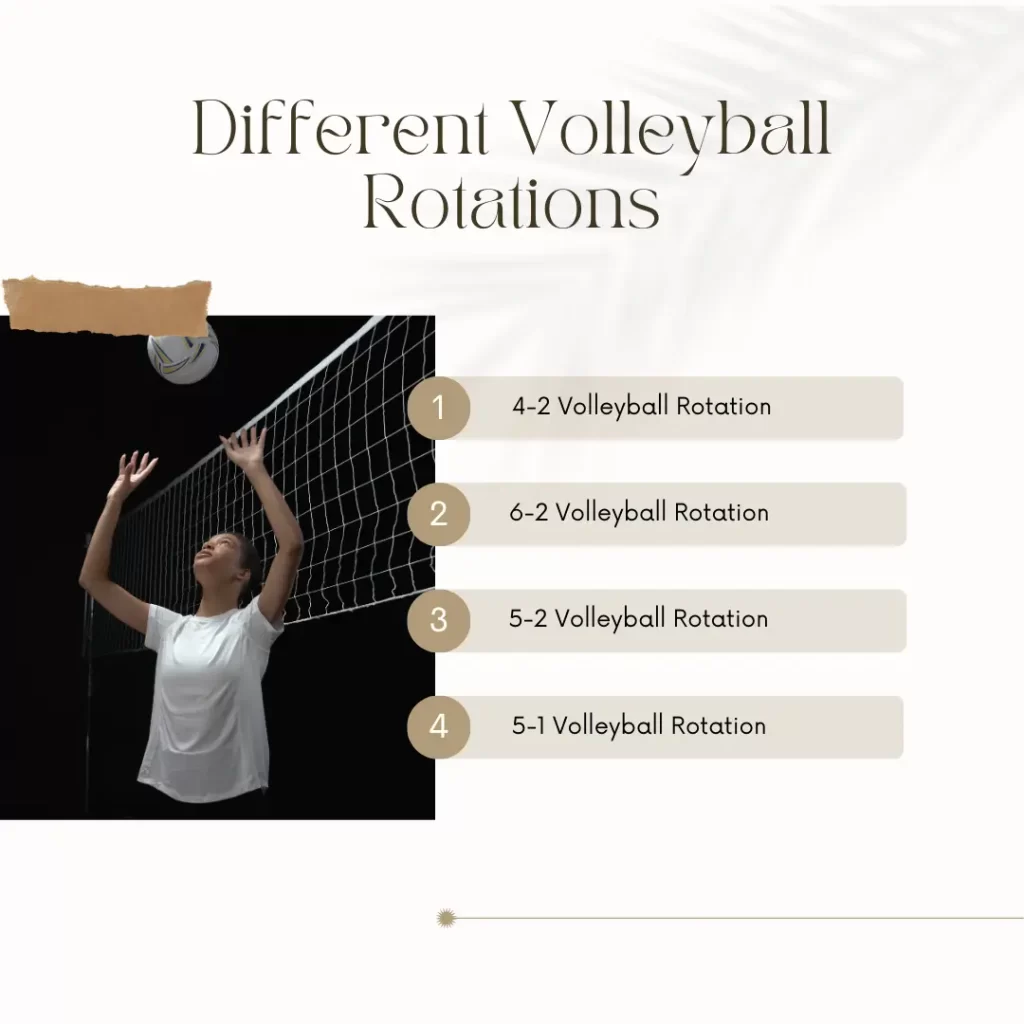
Rotation can also refer to the offensive strategy used by volleyball teams, in addition to how we move around the court.
As well as how many different setters will be employed, each strategy differs slightly depending on where the setter will be playing.
There are benefits and drawbacks to each strategy.
4-2 Volleyball Rotation
Among the simplest volleyball rotation strategies, the 4-2 strategy is the most suitable for beginners.
In this rotation, two setters set from the front row.
At the age of 13, I used this rotation when I started playing volleyball in high school.
6-2 Volleyball Rotation
Another relatively common volleyball rotation used by intermediate teams is the 6-2 rotation.
Teams are able to maximize offensive options with two setters who set exclusively from the back row.
5-2 Volleyball Rotation
As a hybrid between a 6-2 and 5-1 rotation, the 5-2 volleyball rotation is a lesser-known approach.
In this game, two setters are used, one of whom plays only in the front row (they are usually tall) and the other in the back row (they are usually quite short).
5-1 Volleyball Rotation
At higher levels of volleyball, the 5-1 rotation is the most common strategy.
Using this strategy, one setter plays on both the front and back courts, rotating throughout the court.
You may enjoy reading Volleyball Setter Drills
The Best Volleyball Rotations for High Schools
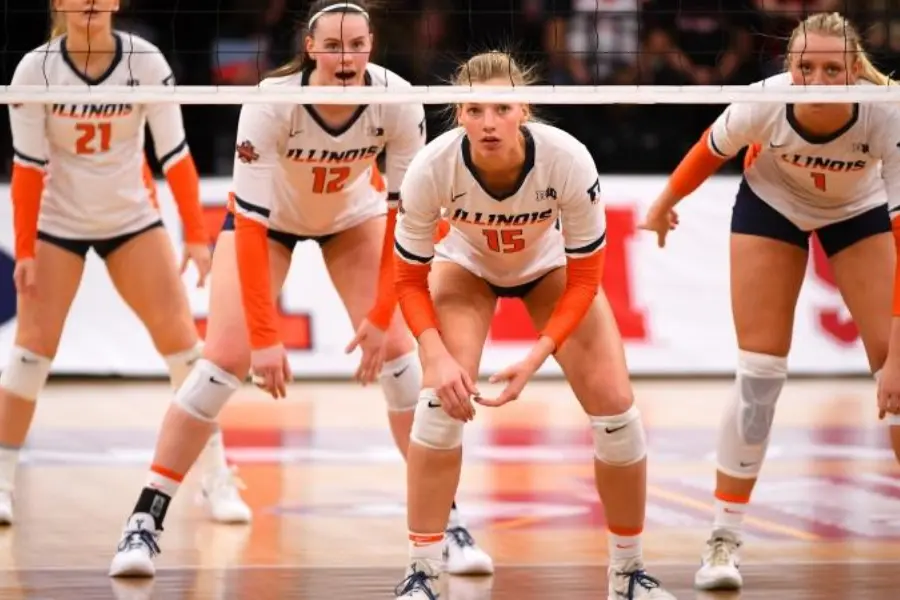
The 4-2 rotation is quite common among younger teams with players aged 10-14.
Having learned this strategy, players can simply enjoy playing volleyball without worrying about complicated rotational rules, such as overlap, that are difficult to understand.
Teams often switch to a 6-2 rotation as players develop.
High school teams will benefit from this option since it allows for a maximum number of front-row attackers (3).
If your team doesn’t have a super tall and intelligent setter, implementing a 5-1 rotation could limit your team offensively. This is especially true for high school players around the age of 12-15.
Depending on your team’s composition and skill level, either a 6-2 rotation or a 5-1 rotation will be ideal for varsity volleyball teams.
How To Memorize Volleyball Rotations?
When it comes to a volleyball serve receiver, it can be difficult to know where to stand on the court at times, especially for younger players.
For each major rotation (linked above), I have written detailed guides including downloadable PDFs showing rotational diagrams for each system.
So that each player is following the rotation rules, you should study the rotation diagrams until you understand why they stand where they do.
6-2 rotations are relatively simple, requiring only three different serve receive formations to learn.
Eventually, these rotations will become second nature as you play more volleyball.
In most cases, your teammates can help you find your way around the court if you get lost.
During practice, ask your coach to simulate a game situation to help you with rotations.
As well as practicing Switching from serve receive to base positions, can be a great way to practice.
FAQs
In regards to volleyball rotations, here are some of the more frequently asked questions.
What is the easiest volleyball rotation?
Volleyball’s 4-2 rotation is the simplest. Next is the 6-2 rotation and the 5-1 rotation is a little more difficult.
How does a libero rotate?
Liberos rotate on the court like everyone else. The middle blocker will play the next three rotations when they’re ready to rotate into the front court (position 4).
Following the MB’s service, the libero comes back on and performs the remaining backcourt rotations.
To enter or exit the court, the libero does not need to make a formal substitution.
Can you be called out of rotation?
Your team will lose a point if it is not in rotation, meaning you aren’t adhering to the overlap rule.
Coaches should be able to help players find the correct standing position since it is usually a fairly quick fix.
Do pro volleyball players rotate?
Yes, absolutely. Whenever a volleyball player sides out, he or she rotates.
Conclusion
Volleyball rotations are essential to success in the sport. Defensively and offensively, a well-coordinated team can benefit from flawless rotations.





